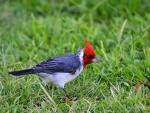One would think we would be surrounded by flocks of tropical birds. Sea birds should abound here. But in reality we see only a few sparrow-like birds picking up picnic droppings off the beach and really, little else. A sighting is rare. Sitting out on the back deck here in the town of Waimea, we're surrounded by tropical plants and trees, yet we see far fewer birds than in our snow-covered cedar hedges in Aurora.
What went wrong?
Most of the mammals on the island of  One, the seemingly innocent Indian Mongoose, is as prevalent here as
One, the seemingly innocent Indian Mongoose, is as prevalent here as
In 1872, W.B. Espeut, a sugar plantation owner in Jamaica, got the idea to introduce the mongoose there in order to keep his rat problem under control.  He sailed from
He sailed from
Twenty years later, in a journal article, the enterprising Espeut claimed he was very successful, thereby creating a new Jamaican export for himself. Selling mongooses! When the article reached the sugar cane plantations of
Imagine, He Lied.
Contrary to Mr. Espeut's claims, Mongooses kill very few rats. Unlike the nocturnal rat, the mongoose is diurnal; they are active during the day! And you can't eat what you don't see. So instead of ridding the islands of night-time rats, the day-time mongooses have found many alternative foodstuff. Only the islands of Lana'i and Kaua'i remained mongoose-free, but on the other islands, the introduction of the little creature has been a disaster of epic proportions.
Over Easy or Scrambled?
Among many other delicacies, they loved the plentiful bounty of the local bird eggs. Mongooses love eggs. They throw the eggs against rocks to break them open and then eat them. The mongooses have preyed on not just the eggs but also fledgling and adult native Hawaiian birds, not to mention endangered sea turtle eggs and hatchlings. Within decades the bird population of the
Endangered Species
The 
If one wants to see flocks of tropical birds, you have to head to the
Most birds are Ha'ole, like us
The colourful Brazilian red breasted cardinal which can be seen in various areas  around the island is a 1930's introduction and although interesting, like so many of the other recent additions, is not native to Hawai'i.
around the island is a 1930's introduction and although interesting, like so many of the other recent additions, is not native to Hawai'i.
More species of birds have been introduced here than anywhere else on earth - at least 142 species of birds, from six continents since 1850, many to replace the devastated native populations. Around 54 of these introduced species have established breeding populations on the islands. But they survive only in small numbers and even then mostly only in secluded, little publicized, bird sanctuaries around the islands.
[if you want to send me an e-mail, click here ]


No comments:
Post a Comment